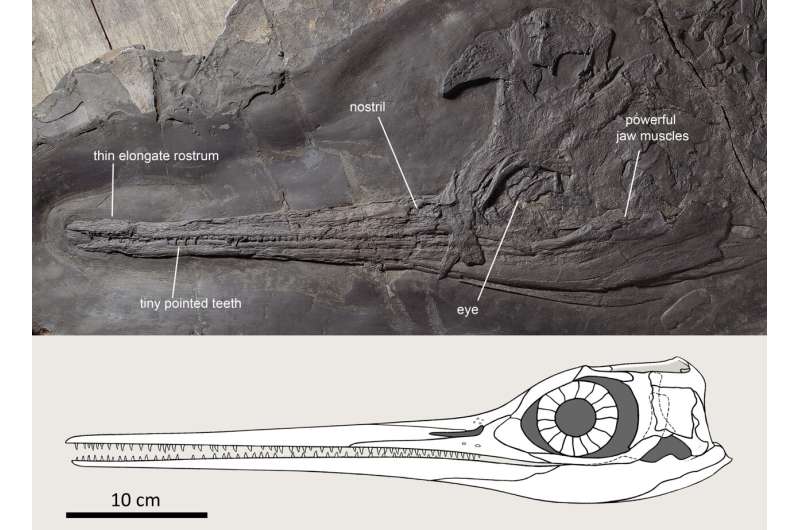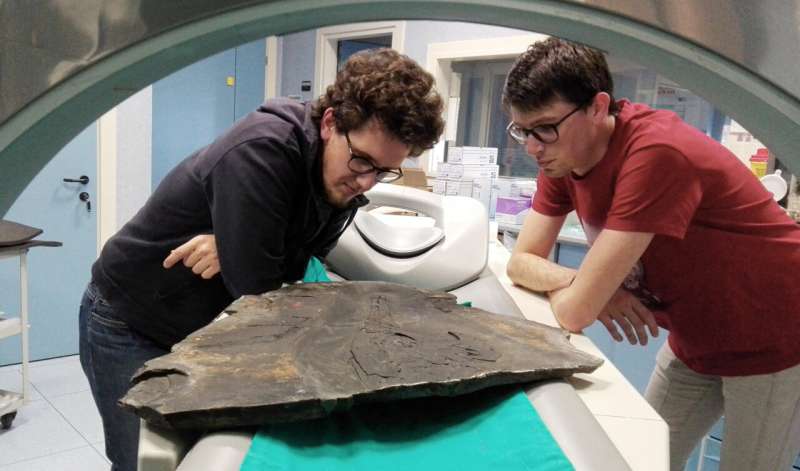The skull of the type specimen of Besanosaurus leptorhynchus is characterized by extreme longirostry (i.e., thin elongate snout), and equipped with tiny pointed teeth, perfect for catching small fish and extinct cousins of squids with rapid snapping moves of the head and jaws. Credit: Gabriele Bindellini and Marco Auditore, © Museo di Storia Naturale di Milano.
Middle Triassic ichthyosaurs are rare, and mostly small in size. The new Besanosaurus specimens described in the peer-reviewed journal PeerJ by Italian, Swiss, Dutch and Polish paleontologists provide new information on the anatomy of this fish-like ancient reptile, revealing its diet and exceptionally large adult size: up to 8 meters, a real record among all marine predators of this geological epoch. In fact, Besanosaurus is the earliest large-sized marine diapsid—the group to which lizards, snakes, crocodiles, and their extinct cousins belong to—with a long and narrow snout.
Besanosaurus leptorhynchus was originally discovered near Besano (Italy) three decades ago, during systematic excavations led by the Natural History Museum of Milan. The PeerJ article re-examines its skull bones in detail and assigns five additional fossils to this species: two previously undescribed fossil specimens, and two fossils previously referred to a different species (Mikadocephalus gracilirostris), which turns out to be not valid due to lack of significant anatomical differences with Besanosaurus.
The six specimens vary mainly in size and likely represent different growth stages. According to this re-analysis, Besanosaurus is the oldest and basal-most representative of a group of ichthyosaurs known as shastasaurids.
All specimens, housed in museums in Milan, Zurich, and Tübingen were collected in the last century from the bituminous black shales of the Monte San Giorgio area (Italy/Switzerland, UNESCO World Heritage), which were deposited some 240 million years ago at the oxygen-depleted bottom of a peculiar marine basin. The locality is famous worldwide for its rich fossil fauna that, besides ichthyosaurs, includes many other marine and semiaquatic reptiles, a variety of fish, and hard-shelled invertebrates.
Credit: Museo di Storia Naturale di Milano
"The extremely long and slender rostrum suggests that Besanosaurus primarily fed on small and elusive prey, feeding lower in the food web than an apex predator: a novel ecological specialization never reported before this epoch of the Triassic in a large diapsid reptile. This might have triggered an increase of body size and lowered competition among the diverse ichthyosaurs that co-existed in this part of the Tethys Ocean," says Gabriele Bindellini of the Earth Science Dept. of Milan University, first author of this study.
At the Fondazione Ospedale Maggiore di Milano, paleontologist Gabriele Bindellini (left) and a student of the Degree in Medical Techniques of Radiology, Alessandro Crasti (right), scan the skull of Besanosaurus leptorhynchus before shifting it into the CT ring. Photo by Cristiano Dal Sasso.
"Studying these fossils was a real challenge. All Besanosaurus specimens have been extremely compressed by deep time and rock pressure, so we used advanced medical CT scanning, photogrammetry techniques and comparisons with other ichthyosaurs to reveal their hidden anatomy and reconstruct their skulls in 3D, bone by bone," remarks Cristiano Dal Sasso of the Natural History Museum of Milan, senior author of the PeerJ article, who in 1996 originally described and named Besanosaurus.
Credit: Museo di Storia Naturale di Milano
Interestingly, the Italian researchers started re-studying the Milan Besanosaurus roughly at the same time an international team including Andrzej Wolniewicz (IP PAS, Warsaw), Feiko Miedema (SMNS, Stuttgart), and Torsten Scheyer (UZH, Zurich) started working on the Swiss specimens. "Rather than doing parallel studies, we pooled our data and efforts and pulled on the same string, to enhance our understanding of these fascinating extinct animals," adds Torsten Scheyer.
More information: Gabriele Bindellini et al. Cranial anatomy of Besanosaurus leptorhynchus Dal Sasso & Pinna, 1996 (Reptilia: Ichthyosauria) from the Middle Triassic Besano Formation of Monte San Giorgio, Italy/Switzerland: taxonomic and palaeobiological implications, PeerJ (2021). DOI: 10.7717/peerj.11179
Journal information: PeerJ
Provided by PeerJ

























